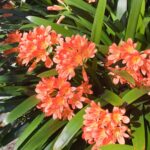Whether they are fashionable or not, everyone has at least one indoor plant lurking somewhere in their house. Most indoor plants have a limited life and keeping them healthy inside can be difficult.
Happy plant
One popular indoor plant is the Chinese happy plant, Dracaena fragrans ‘Massangeana’, a variegated plant that sprouts from a piece of apparently dead wood. Happy plants are extremely tolerant of harsh conditions and many have survived indoors for more than 20 years.
The new way to grow a happy plant is with the leafy crown on top of a straight, strong trunk which looks something like an elephant’s leg. The trend is towards solid green foliage rather than variegated leaves.
Indoor plant care
Many rooms are simply not appropriate for the cultivation of indoor plants. Those in older style houses with small windows are an obvious example. Ideally a room where indoor plants are grown should have large picture windows or a skylight to provide adequate light for plant growth. Many of the more popular indoor plants, such as maidenhair ferns, need strong light to flourish.
Most people water indoor plants once a week or once a fortnight during winter. The most reliable method of knowing when to water is to poke your finger into the potting mix surrounding the plant, down to about 2.5cm (1″). If the mix is dry then water the plant, if it is not then don’t. When plants are watered allow water to drain away from the base of the plant. Do not leave plants to stand in saucers of water.
Overwatering kills many plants as does over fertilising. Indoor plants are not growing so they do not require much feeding at all.
Recommended fertilising: Either once a year apply a small amount of slow release fertiliser or use a liquid fertiliser such as Nitrosol sparingly once or twice a year.
Many indoor plants require a holiday outdoors each year (or more frequently) if they are to keep up appearances. Do not leave indoor plants outside during winter as the cold weather may damage them. Instead move them outdoors in the warmer months into the shelter of a shady tree or shadehouse. Water the foliage to clean the leaves and repot if necessary. Leave outside for at least six weeks but don’t leave in a hot or sunny position and don’t forget to check the plants regularly and to water them.
Hint: When bringing plants back inside after a spell outdoors, check the plants carefully for snails or caterpillars. Snails may congregate around the rim of the pot. Caterpillars may be found on or under the leaves.
If your happy plant has got too high for the room, cut it back and use the cut pieces as cutting material to grow new plants.
Trivia
Happy plants are supposedly called ‘happy’ as they are thought to bring luck to the household. If the plants flower, which sometimes occurs especially with old plants or those grown in warm climates, it is also considered to be a sign of good fortune.
Cost and availability
Happy plants are available from nurseries throughout Australia and are best bought in October or November when the weather is warmer.



